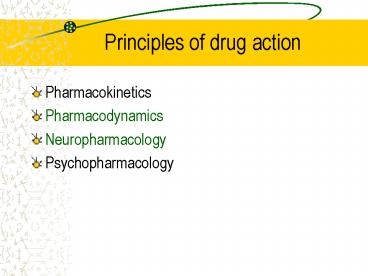Principles of drug action - PowerPoint PPT Presentation
1 / 17
Title:
Principles of drug action
Description:
Change is proportional to % receptors occupied or by rate of reversible binding ... Effects are agonistic or antagonistic. Receptor types ... – PowerPoint PPT presentation
Number of Views:630
Avg rating:3.0/5.0
Title: Principles of drug action
1
Principles of drug action
- Pharmacokinetics
- Pharmacodynamics
- Neuropharmacology
- Psychopharmacology
2
Pharmacodynamics
- Drug-receptor interactions
- Receptor complexes and the action of ligands
- Transmembrane potential changes via receptor
complex - Change is proportional to receptors occupied or
by rate of reversible binding (attachment) of
ligand - Effects are agonistic or antagonistic
3
Receptor types
- These membrane-spanning proteins are coils of 7
or 12 transmembrane loops, called alpha-helical
coils. There are four types - Ion channel receptor complexes respond to
neurotransmitters from outside or G proteins from
inside the cell. Drugs can affect either. - Carrier/transporter proteins, especially for
reuptake - G-protein-coupled receptors and enzyme cascades
- G is for guanine, a cellular nucleotide affected
by these receptors - Enzymes
4
Ways a drug may act on a neuron or synapse
- Manufacture Increase or block
- Packaging Make vesicles leaky
- Transport Block or facilitate vesicle movement
- In the synapse
- Mimic
- Block
- Post-synaptic receptors and autoreceptors
- After reversible binding Enzymes or reuptake
5
Pharmacodynamics
- Drug-receptor affinity
- Governed by stereochemical fit
- Effects on brain determined by location of
receptor types
6
The dose-response relationship
- Dose
- Potency
- Efficacy or maximum effect
- Slope
7
The dose-response curve
- The dose-response curve relates the amount
administered to the response. - Response may be measured as responding or as
intensity of response
8
The dose-response curve Effectiveness and safety
9
Drug variability and toxicity assessment
- ED50 Effective dose for 50 of subjects
- TD50 Toxic dose for 50 of subjects
- Both ED50 and TD50 are different for each effect
- The therapeutic index
- TI TD50 / ED50
- No drug is 100 safe
- Placebo effects
- The FDA and drug development
10
FDA rules
- Pure Food and Drug Act, 1906 Labeling accuracy
to eliminate adulteration - Cuforhedake Brane-Fude, labeled 30 alcohol
- Sherley Amendment, 1912 No false and
fraudulent therapeutic claims on the label - Harrison Narcotics Act, 1914 Trade controls and
taxation (Dr. Hamilton Wright) - Marijuana Tax Act (1937) Harry Anslinger
- Agriculture Department vs. Treasury Dept.
- Enforcement concerns merged under Department of
Justice, 1968? DEA, 1973
11
Expansion of FDA concerns
- Purity (1906)
- Safety (1938) The Food, Drug, and Cosmetics Act
- Toxicity assessment before marketing
- Instructions for use on the label
- Effectiveness (1962) Kefauver-Harris amendments
- Carters Little Liver Pills
12
The Australian approach
- The Therapeutic Goods Administration (TGA)
- Drug Safety and Evaluation Branch
- Adverse Drugs Reaction Unit (ADRU)
- Manufacturers and suppliers (importers) are known
as sponsors, and are responsible for both entry
into the Australian Register of Therapeutic Goods
and reporting of postmarketing adverse reactions
to the ADRU. - Only the ADRU reports must be based on Australian
populations. - Uses a partnership approach.
13
The TGA
- Established by the Therapeutic Goods Act of 1989
- A unit of the federal department of Health and
Ageing. - Covers assessment and monitoring activities
- Focuses on Quality, Safety, and Effectiveness
- Defines therapeutic goods
- Website www.tga.gov.au/about/about.htm
14
Current FDA Approval Process
- Safety Pre-clinical testing of several dosages
over relevant time periods on at least two
species - Carefully planned clinical trials with signed
informed consent and annual reports - Phase 1 clinical trials Small doses on healthy
volunteers Pharmacokinetics and side effects - Phase 2 Small sample of hospital patients
- Phase 3 Broader clinical trials on patients
15
The Controlled Substances Act, 1970
- Schedule system Based on abuse potential,
medical usefulness, and risk of dependence - Schedule I Hi-no-hi. Heroin, marijuana, LSD
- Schedule II Hi-yes-hi. Morphine, Marinol,
cocaine, methamphetamine - Schedule III Moderate-yes-moderate.
Amphetamine, barbiturates, PCP - Schedule IV Low-yes-less than III. Chloral
hydrate - Schedule V Low-yes-less than IV. Cocaine
mixtures
16
More recent legislation
- The Orphan Drug Act, 1983
- Analogue (Designer Drug) Act, 1986
- Prescription Drug Marketing Act, 1987
- Anti-Drug Abuse Act, 1988 (established ONDCP)
- aka Omnibus Drug Act
- Anabolic Steroids Control Act, 1990
- http//www.druglibrary.org/schaffer/History/drug_l
aw_timeline.htm
17
Harry J. Anslinger
Marijuana is smoked by musicians. And Im not
speaking about good musicians, but the
jazz type. -Commissioner of the U.S. Bureau of
Narcotics, 1930-1962





![[PDF] Principles of Drug Action: The Basis of Pharmacology, 3e Ipad PowerPoint PPT Presentation](https://s3.amazonaws.com/images.powershow.com/10087817.th0.jpg?_=202407290612)


![[PDF] Pharmacology: Drug Actions and Reactions (PHARMACOLOGY- DRUG ACTIONS & REACTIONS (LEVINE)) 7th Edition Ipad PowerPoint PPT Presentation](https://s3.amazonaws.com/images.powershow.com/10086640.th0.jpg?_=202407260912)




![[PDF]❤️DOWNLOAD⚡️ Coffeeland: One Man's Dark Empire and the Making of Our Favorite Drug Pape PowerPoint PPT Presentation](https://s3.amazonaws.com/images.powershow.com/10098748.th0.jpg?_=20240814012)

















